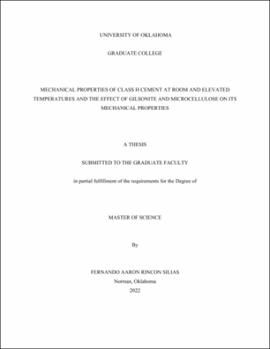| dc.description.abstract | With an increase in global energy demands, the importance of well integrity and the oilfield cements has become more important than ever as it guarantees the continuous supply of fossil fuel to fulfill the requirement of the world. Drilling operations in recent years have gone into much deeper depths to meet the global demands in hydrocarbons, geothermal, gas storage and carbon sequestration purposes. In well integrity, cement plays a crucial role as it seals/isolates the troublesome formation or thief zone meanwhile protect the casing from corrosion and giving structural support to it. Therefore, it is necessary that cement slurry characteristics should be designed according to the subsurface environment, thus a proper characterization of the mechanical properties of cement in the laboratory is mandatory get to know its behavior when exposed to downhole conditions, and cubes and cylinders are the most commonly used shapes to characterized the mechanical properties, nevertheless, American Petroleum Institute (API) does not have a recommendation for cylinders, moreover, a review of American Society for Testing and Materials (ASTM) and British standards (BS) for the UCS is given, hence a study to determine if a correlation between cubes and cylinders can be achieved is studied.
Though there are many conventional additives in the market but unconventional additives like Gilsonite and Microcellulose is not extensively studied. Gilsonite is a naturally occurring additive that is derived from hydrocarbons classified as asphaltite. It has been used in water-based drilling fluid and sometimes with an oil base mud as a treatment for filtration and sloughing shale problems. Given the useful properties of Gilsonite such as impermeability, low specific gravity and its great corrosive and acidic resistance it has been used as a loss of circulation material in cement applications. Micro-cellulose (MC) has been reported as a great additive in geothermal well fluid loss curing solutions. Given the recent success of using Micro-Cellulose in curing loss circulation and providing Wellbore Strengthening, addition of some amount to the cement slurry could inevitably be an option for cement fluid loss cure. However, the Micro-Cellulose can change the hydration process on the cement due to its natural characteristics, decreasing the compressive strength of the cement at the early stages; this phenomenon will be further described in the paper
This paper shows the results of more than 100 tests conducted on cement cubes and cylinders to determine if a correlation between cubes and cylinders can be obtained, cubes and cylinders samples of class H cement at room and elevated temperature were prepared, and an investigation of more than 500 test was performed to show the effect of age (up to 120 days) and temperature (23c and 75c) on class H neat, H + 4% Microcellulose and 4% Gilsonite to investigate the effect of those additives in the mechanical properties of the cement.
It was observed that variation in the results existed in the UCS when cubes are compared with the cylinder, which raises the importance of the development of the new standard. The results showed the high compressive strength of the cube as much as 50% and 35% for the sample cured at high and room temperature respectively. Moreover, no correlation existed between the cylinder cured at high temperature and UCS or UPV. Whereas the cube sample was able to give a logarithmic or exponential correlation for all the testing scenarios. Hence a better understanding of the cylindrical sample is needed and the data from this research can help to compare the results from these two geometries.
This research also focuses on the evaluation of mechanical properties of Gilsonite and Microcellulose (MC) cement composite and compared with neat Class H cement. The compressive strength of the cement is measured through a direct and indirect method. Samples were cured at high temperatures (75°C) and at ambient conditions for the period of 1, 3, 7, 14, 21, 28, 35, 60, 90 and 120 days. It was found that at high temperature (HT) the development of compressive strength in 4% Gilsonite cement composite was very rapid with the UCS going as high as 42MPa within three days of curing. Whereas 4% MC shows an identical behavior as Gilsonite at room temperature, but a decrease in strength at HT when compared to Gilsonite or neat class H cement. | en_US |
